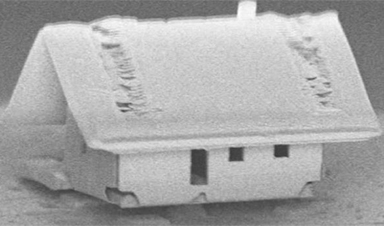Scientists have assembled the world’s smallest house by using a combination of robotics and nanotechnology. The micro-house even has a door that a house mite can fit through.
The house has been devised, according to Engadget, as a proof-of-concept study from a nanorobotics team based at the Femto-ST Institute in Besancon, France. The researchers successfully assembled a new microbotics system termed the μRobotex nanofactory. By deploying tiny robots the researchers can construct microstructures within a large vacuum chamber. Within this they can fix components onto optical fiber tips at a level of nanometer accuracy.
The idea behind the microhouse construction was in order to demonstrate that the latest advances in optical sensing technologies can be used to manipulate ion guns (via gas injection), electron beams and finely controlled robotic piloting, so that a variety of different constructs can be rendered. As an example of the complexity and tiny scale of operations, the ion gun focuses on an area only 300 micrometers by 300 micrometers so that it can to fire ions onto the fiber tip and silica membrane.
This forms part of the area of lab-on-fiber technologies. In the early stages of this technology there were no robotic actuators available for for nanoassembly, which limited what engineers could achieve in terms of creating microstructures at the nano-scale. A recent advance in miniaturtized-sensing elements has addressed this. These sensing elements can be fitted onto fiber tips, allowing scientists to manipulate different components.
The technology allows enables scientists to insert optical fibers as thin as a strand of human hair into previously inaccessible locations such as jet engines, to detect radiation levels, or into human blood vessels to detect viral particles.
Image Credit: FEMTO-ST Institute
News This Week
New Once-a-Week Shot Promises Life-Changing Relief for Parkinson’s Patients
A once-a-week shot from Australian scientists could spare people with Parkinson’s the grind of taking pills several times a day. The tiny, biodegradable gel sits under the skin and releases steady doses of two [...]
Weekly injectable drug offers hope for Parkinson’s patients
A new weekly injectable drug could transform the lives of more than eight million people living with Parkinson's disease, potentially replacing the need for multiple daily tablets. Scientists from the University of South Australia [...]
Most Plastic in the Ocean Is Invisible—And Deadly
Nanoplastics—particles smaller than a human hair—can pass through cell walls and enter the food web. New research suggest 27 million metric tons of nanoplastics are spread across just the top layer of the North [...]
Repurposed drugs could calm the immune system’s response to nanomedicine
An international study led by researchers at the University of Colorado Anschutz Medical Campus has identified a promising strategy to enhance the safety of nanomedicines, advanced therapies often used in cancer and vaccine treatments, [...]
Nano-Enhanced Hydrogel Strategies for Cartilage Repair
A recent article in Engineering describes the development of a protein-based nanocomposite hydrogel designed to deliver two therapeutic agents—dexamethasone (Dex) and kartogenin (KGN)—to support cartilage repair. The hydrogel is engineered to modulate immune responses and promote [...]
New Cancer Drug Blocks Tumors Without Debilitating Side Effects
A new drug targets RAS-PI3Kα pathways without harmful side effects. It was developed using high-performance computing and AI. A new cancer drug candidate, developed through a collaboration between Lawrence Livermore National Laboratory (LLNL), BridgeBio Oncology [...]
Scientists Are Pretty Close to Replicating the First Thing That Ever Lived
For 400 million years, a leading hypothesis claims, Earth was an “RNA World,” meaning that life must’ve first replicated from RNA before the arrival of proteins and DNA. Unfortunately, scientists have failed to find [...]
Why ‘Peniaphobia’ Is Exploding Among Young People (And Why We Should Be Concerned)
An insidious illness is taking hold among a growing proportion of young people. Little known to the general public, peniaphobia—the fear of becoming poor—is gaining ground among teens and young adults. Discover the causes [...]














Leave A Comment